Sustainable fisheries require taking care of fish and their homes so they can keep thriving. It’s about making sure we don’t catch too many, protect the environment, and support the communities that depend on fishing. One crucial aspect of maintaining sustainable fisheries is effective resource management.
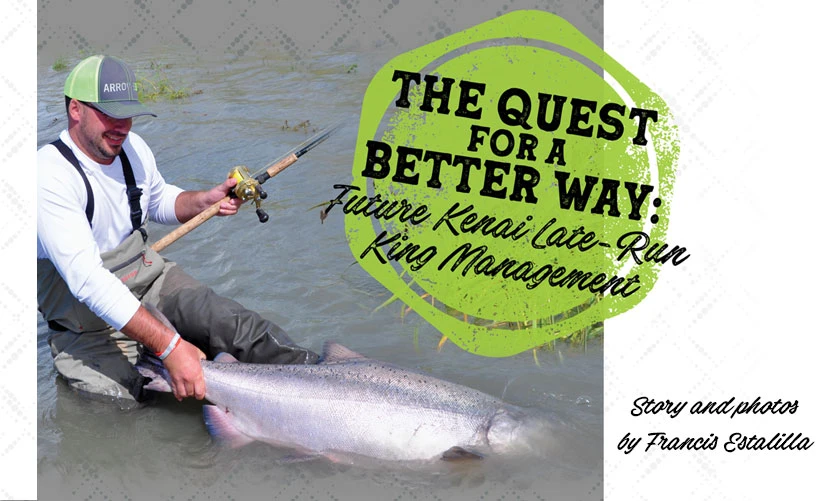
Ensuring the Future of Late-Run Kenai River King Salmon Through Sustainable Fisheries Practices.
It’s the dead of winter as I’m writing this, but my mind is already reaching forward to July and the late run of Kenai River kings. As I contemplate the upcoming season, it’s difficult to ignore how poorly the late run performed last summer. It’s even more difficult to fathom the seeming carelessness in how the Alaska Department of Fish and Game (ADF&G) responded to the crisis. Simply put, it was beyond awful.
Reflections on Past Seasons
Looking back more holistically and analytically on the past ten seasons, allow me to share a few observations to put last year into proper perspective
- With the singular exception of 2017, every year required in-season restrictions on late-run king fishing.
- With a singular exception, every year began with regulations allowing participants to “kill ‘em all,” meaning allowing the harvest of any king salmon. Much to the surprise of stakeholders, in 2020, ADF&G started the season prohibiting the retention of large fish exceeding 34 inches, the first year that specific management tool was made available for them to use.
- 50% of those ten seasons ultimately went to full closure of king fishing despite in-season step-down action to help boost escapement past the fishery.
- Catch-and-release (C&R) restrictions were required 60% of the time, typically invoked around mid-July by emergency order, with an additional 48 hours to give users sufficient lead time for the “urgent” rule change. In other words, it typically took 17 days to effectively enact a step-down to C&R on the water.
- Whenever a run was so weak as to invoke C&R restrictions, the delayed action meant there was ultimately an 83% risk of going to full closure of the king fishery (5 of 6 seasons).
- Only once (2018) was C&R invoked early enough to prevent full closure.
- Since the inception of the large-fish goal, ADF&G has FAILED to achieve its conservation objective 60% of the time.
Critical Large-Fish Escapement Goals
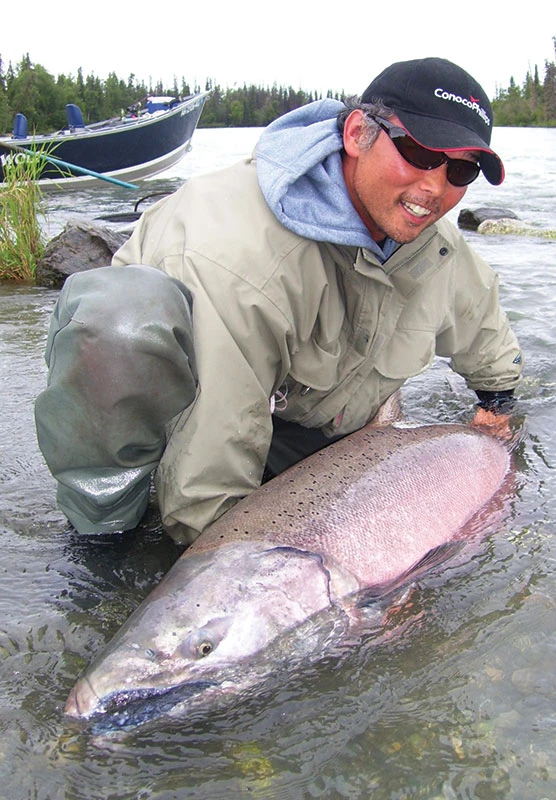
Noel Estalilla releases a large Kenai king on Driftboat Monday. © Francis Estalilla
Said another way, the large-fish goal has only been met 40% of the time. When I went to school, that was a grade F-minus! Consistently meeting the conservation goal for large fish is simply NOT happening, and that’s a critical misstep. Why? The 34-inch threshold of the large-fish goal is so incredibly important because virtually all Kenai hens are larger than 34 inches. Any time the sport fishery is restricted to non-retention over 34 inches, it effectively eliminates the purposeful harvest of essentially all hens. Only a fool would deny that the most fundamental stepping stone for restoring the horribly depleted Kenai kings is optimally seeding the spawning gravel with eggs. A wise Latino scholar once quipped, “No huevos, no pollo.” Bottom line, when the population is floundering at rock bottom, optimizing the escapement of large, egg-laden females is paramount to stock recovery.
Considering these observations, it quickly becomes obvious that liberally starting the July season by permitting the retention of all sizes of Kenai kings (kill ‘em all) has done the resource no favors, and likely, significant damage. The misguided notion that ADF&G can prudently ratchet the fishery down after the fact simply fails the smell test against real-time conditions. The verdict based on historic facts? It stinks! And it fails almost every time.
Reactive Closures Prove Ineffective
By the time ADF&G acknowledges the run could be in trouble, we’re already mid-way through the late-run fishing season! There are only two more weeks for any reactive step-down action to create meaningful savings. Then there’s that extra 48-hour delay between issuing the emergency order and actually enforcing it. Damage continues to accrue for another two days of intentionally killing large kings at a time in the run when it’s most impactful. And that’s just for one incremental step down in the plan. Each additional step in conservation entails yet another two-day delay to implement from the time the actual decision is made to step down, further eroding the potential for any substantial savings.
Moreover, a step-down approach is socially and economically disruptive to the fishing industry, local commerce, and the participants in the fishery. Visiting anglers have already booked their accommodations, purchased king gear, and paid for their king stamp. The last thing they want to face is unexpected restrictions or closure. Guides are made to scramble, re-booking cancellations for other options. Ditto for those in the lodging industry as well as other expectant businesses reliant on folks coming to experience a vibrant fishery.
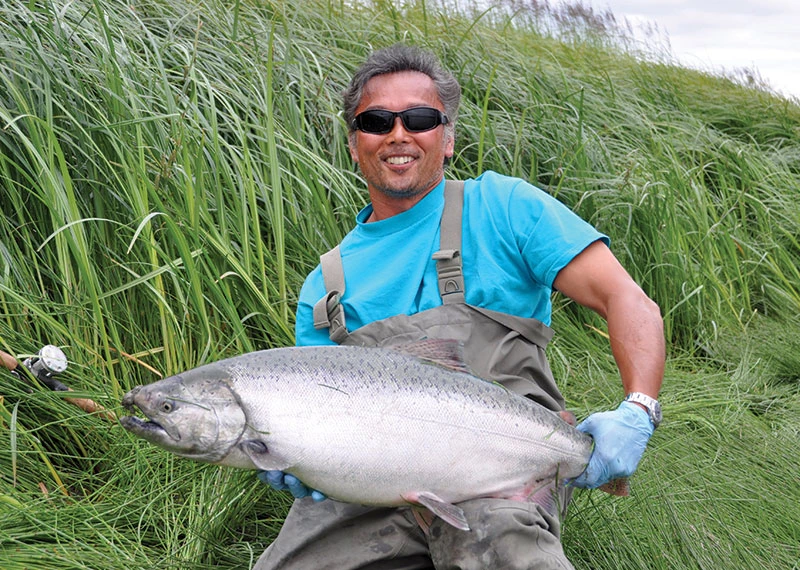
Small Kenai bucks are the perfect eater fish for the box when retention of such fish is allowed. © Francis Estalilla
Risk to Stock and Conservation Failures
Most importantly, a step-down approach is exceedingly risky to the stock. The undeniable reality is that managers looking to fulfill the large-fish goal can’t possibly “un-kill” the fish that have already been harvested. History amply demonstrates that ADF&G’s willingness to act is typically delayed by misguided wishful thinking that more fish will expectantly arrive. “The fish are just a few days late…The tides are bad…The water’s dirty and the fleet’s not taking that many…How much could it really hurt to wait just a little longer?” Unfortunately, by the time they are spurred to prudent action, the damage has been done and is irreversible. Acting too late has proven to be extremely harmful to Chinook conservation, and acting too late is what happens with the step-down approach.
The historic record speaks for itself! It is replete with failures to meet even the bare-minimum conservation standard stipulated in the current management plan. But even on those occasions when it has been met, escapement has consistently been in the lower half of the optimal escapement goal (OEG) range, typically teetering on falling through the escapement floor. Enough is enough!
Call for a Conservation-Minded Changes
It’s high time for a course correction for the harvest management of late-run Kenai kings. The current paradigm is overdue for a hard reset that conservatively starts the season with the reins on harvest tightly held back until the true run strength reveals itself in real time. Then, and only then, should the rules be conditionally relaxed in incremental fashion, in proportion to the strength of the return, as the season unfolds. This more precautionary, proactive, “step-up” approach sets more realistic expectations for users, is more stable and predictable for managers and industry…And most importantly, it significantly reduces risk to the resource. Under a conservative step-up plan, even if in-season changes are delayed as in past years, acting too late is exponentially unlikely to hurt the fish.
Early-Run as a Guideline
Exactly how conservative to begin the July season starts by carefully considering the preseason forecast for late-run kings. Look no further than the conceptual sideboards of the early-run plan as a prudent guideline and precedent-setting model for prosecuting the July (late-run) fishery.
The early-run management plan approved by the Board of Fisheries in 2017 was a landmark achievement in conservation and harvest reform. The plan has two phases, 1) a preseason phase to set expectations for the upcoming fishing season, and 2) an in-season phase to further refine managing the run in real time.
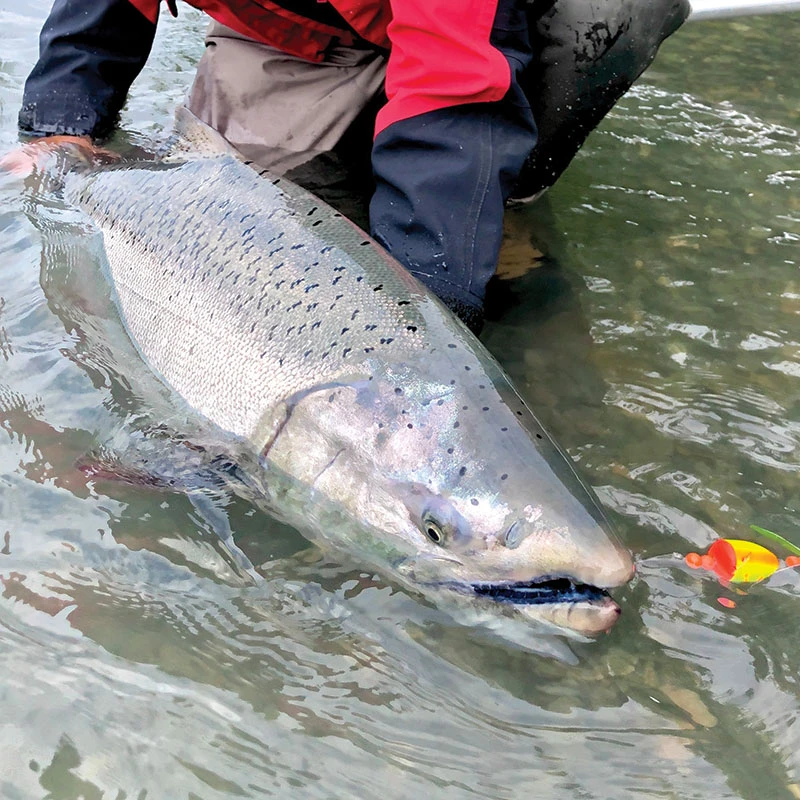
A tide-fresh Kenai buck ready to be released. © Francis Estalilla
Preserving Sustainable Fisheries
For the early run, conservative regulatory season is predicated on the expected abundance in the pre-season forecast during Phase 1. If the forecast falls within the more generous OEG range of 3,900 – 6,600 large fish, the season begins with single hook, artificial lure (no bait), and no retention of kings over 34 inches. Essentially, this would be the expected baseline fishery as long as the forecast is at least large enough to fall comfortably within the OEG.
If the forecast falls short of the lower OEG (less than 3,900), the season may start with either no retention (catch-and-release only) or possibly closure at ADF&G’s discretion. If the forecast falls short of ADF&G’s even stricter sustainable escapement goal range (SEG) of 2,800 – 5,600, the early run fishery is preemptively closed by emergency order. To be clear, any preseason forecast less than 2,800 large fish automatically triggers an emergency preemptive closure upon its public news release.
In-Season Escapement Projection
Phase 2 kicks in once the season is underway, at which time an in-season escapement projection is made no later than mid-June. If that in-season projection falls short of the lower OEG, the fishery is closed by emergency order. If the projection falls within the OEG, the fishery can continue C&R or no retention over 34 inches at ADF&G’s discretion. To date, the more liberal option is typically chosen, while C&R has mainly been invoked to prevent the projection from falling through the escapement floor. If, by some miracle, the projection exceeds the upper bound of the OEG, the fishery may be liberalized with bait and/or retention of all sizes of kings.
In summary, the early-run toolbox allows managers to conceptually reach for one of four tools (in-season) depending on how the run is performing relative to the projected escapement.
- Below the lower goal post (OEG)…CLOSE the fishery.
- Hovering at or just above the lower goal (OEG) post…C&R.
- Clearly within the OEG goal posts…No retention over 34 inches.
- Above the upper OEG goal post…Liberalize with bait and/or retention of all sizes
Applying Early-Run Principles to Late-Run Management
Moving forward, the Board of Fish (BOF) would be wise to confer a similarly conservation-minded plan upon the languishing late run in July. Moreover, because of the recurring discretionary management faux pas, particularly in the past three years, ADF&G’s marching orders must require an even more prescriptive and precautionary paradigm going forward. After considerable thought, allow me to conceptually unveil these proactive recommendations here and now.
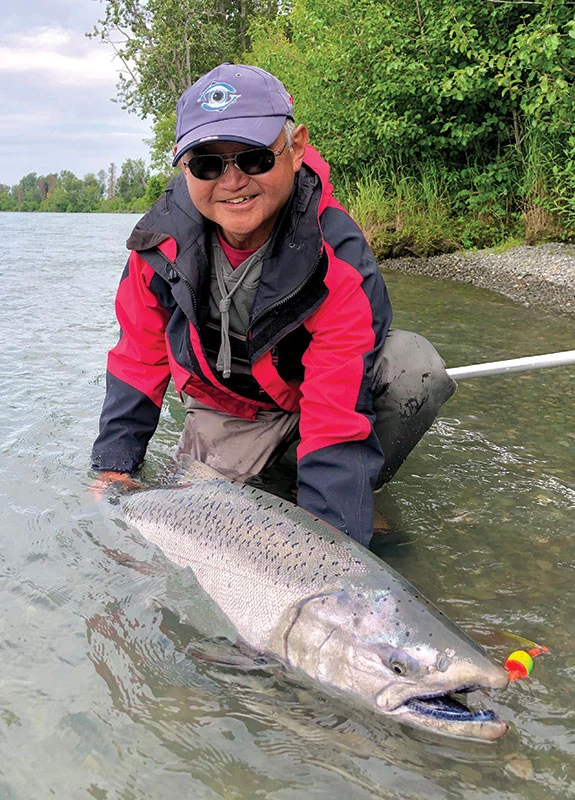
Kelvin Kato displays a large Kenai buck for the release. © Francis Estalilla
Conservative Start for July Fishery
Based on the preseason forecast, the July fishery in Phase 1 shall start with a single hook, artificial lure (no bait), and:
- A) No harvest over 34” if the forecast exceeds the lower quartile of the OEG range (> 18,750)
- B) No harvest (C&R) if the forecast is within the lower quartile of the OEG range (< 18,750)
- C) CLOSURE if the forecast is less than the lower OEG (< 15,000)
Starting July out “kill ‘em all” shall be prohibited in permanent regulation until returns consistently exceed the upper OEG goal for at least a full Chinook life cycle (seven years).
In-Season Monitoring and Adjustments
Once the season is underway during Phase 2, careful monitoring of the return as it unfolds in real time shall guide whether ADF&G stays the course, considers any potential step-up liberalization of the fishery, or makes an even more conservative step-down course correction.
In-season action shall be considered no later than the historic 25% sonar-passage date. An in-season escapement projection shall be made based on average run timing, and shall be reassessed at least weekly thereafter. In-season action shall occur in tiered fashion as follows:
- Closure if the in-season escapement projection (EP) is less than the lower OEG (< 15,000)
- No retention (C&R) if the EP is within the lower quartile of the OEG (15,000 – 18,750)
- No retention over 34” if the EP exceeds the lower quartile of the OEG (> 18,750)
- Allow bait if the EP is within the upper quartile of the OEG (> 26,250)
- Allow harvest of all sizes if the EP exceeds the upper OEG (> 30,000)
Considerations for In-Season Liberalization
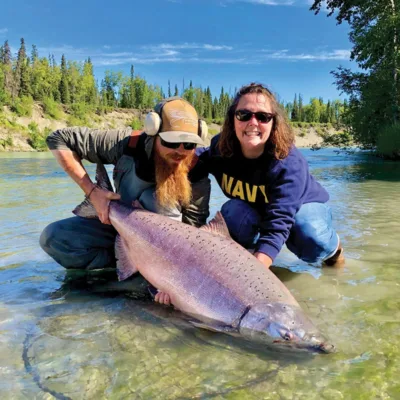
Kenai guide Cody Dutcher releases a large king. © Wendi Dutcher
When considering an in-season liberalization, staff shall account for the expected additional effort and harvest that would accrue to the fleet, and its effect on reducing the escapement projection. The liberalization shall not occur if doing so would reduce the escapement projection below the action threshold for the respective tier. In other words, staff is prevented from stepping up without sufficient “cushion” to buffer the effects of increased participation and harvest that would happen with liberalizing the season.
I believe these are the necessary in-river harvest reforms required to right this sinking ship, and finally steer Kenai kings toward recovery. While it may seem unduly prescriptive, it’s the only way for the BOF to effectively rein in the errors ADF&G has been so prone in the past. Note that the recommendations repeatedly use the word “shall” instead of “may.” This is intentional to prevent the poor management decisions that have been repeatedly made in the past. It will necessarily require discipline on ADF&G’s part to stay on script, but in practice, meeting the conservation benchmark actually becomes easier to achieve. They’d just need to follow the plan!
Proposed Shared Conservation Tiers
Having made it this far into the discussion, many of you are probably wondering, “OK, for the sake of the fish, we could do all of that…But what about the nets?” Clearly, the burden of conservation should not fall entirely on the in-river (sportfishing) sector. The east-side setnetters (ESSNs) must also share in this conservation effort with an appropriately paired action plan. I propose the following shared conservation tiers:
- Sport closure = closure of ESSNs
- No retention (C&R) for sports = no more than 12 hours per week for ESSNs
- No retention greater than 34” for sports = no more than 24 hours per week for ESSNs
- Allow bait for sports = no more than 36 hours per week for ESSNs
- Full sport fishery = no more than 48 hours per week for ESSNs
Balancing Liberalization with Conservation
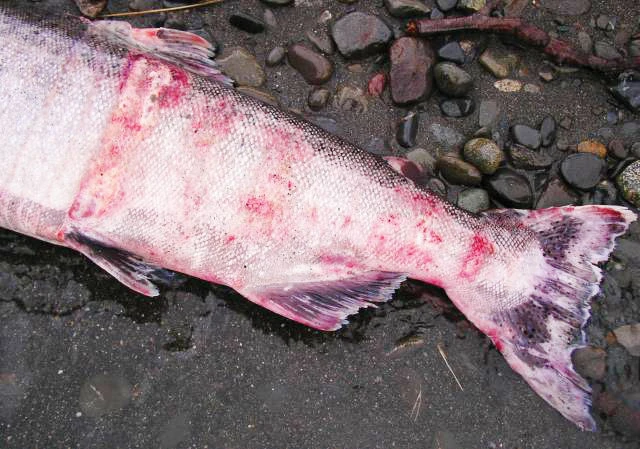
A gill net has no conscience; it can’t tell a king from a sockeye. Another horribly gill-net-marked Kenai king. ©Francis Estalilla
Once again, when considering a liberalization, staff shall account for the increased harvest of Kenai kings in the ESSNs in reducing the escapement projection if the step-up were to occur. Staff shall not liberalize unless there is sufficient cushion in the escapement projection to buffer the additional aggregate harvest entailed both in-river and in the commercial (ESSN) fishery. If the liberalization would cause the escapement projection to fall into a lower tier, it’s a no-go.
There are certainly tradeoffs in what I have proposed here, particularly about prioritizing conservation measures to prevent overfishing a weak stock (late-run Chinook) in favor of potentially “underfishing” a much stronger stock (late-run sockeye). This plan necessarily entails forgone harvest of nearshore-migrating sockeye in Cook Inlet to protect Kenai kings…But only because of the inherent non-selectivity of the current gear type used by ESSNs (set gillnets).
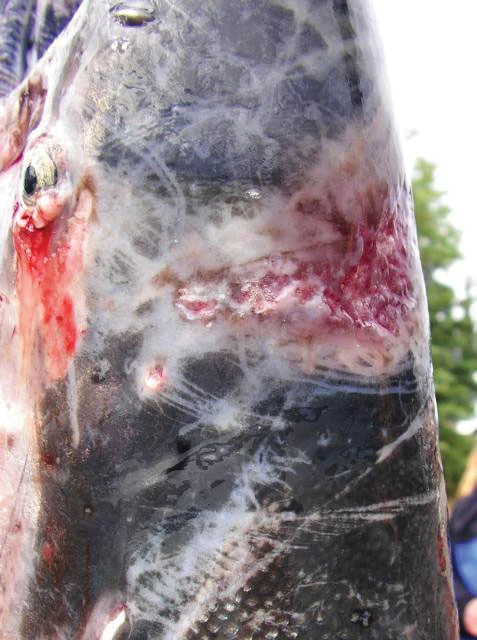
This Kenai king suffered deep coronal ulceration and peri-ocular abrasion inflicted by a sockeye gillnet. © Francis Estalilla
Spurring Innovation for Sustainable Harvest
If nothing else, the proposed constraints on the traditional ESSN fishery should spur more innovation within the industry to gain optimum harvest access to a bumper crop of sockeye while simultaneously protecting depleted chinook. The long-term viability of a nearshore eastside sockeye fishery hinges on live capture techniques that permit live-sorting of non-target Chinook. The BOF must begin to take steps to incentivize alternative commercial gear that meets this objective. Without such proactive initiatives, the Kenai’s most economically valuable salmon stocks are almost certainly destined for a WIN-LOSE outcome. Forward-thinking action today to help make live capture/sorting in the commercial fishery a reality carries the promise of a long-term WIN-WIN to maximize sockeye harvest (as well as produce a more marketable, higher-quality product) while protecting Kenai kings.
Bold Management Steps for Long-Term Sustainable Fisheries
These are the bold management steps that should have been taken years ago. I’ll concede that they may at first seem a bit radical and overly complex. However, when carefully considered, especially by those already in the fish management game, they are really just extensions of familiar concepts already in play in May and June, only more conservatively implemented…And with more “teeth” to produce the desired result of achieving more diverse, healthy Chinook escapements, especially in the upper half of the OEG range. We’ve spent decades trying to “gum” our way out of this dilemma, pitifully aiming for the bottom of the king goal, without any movement toward meaningful stock recovery. I look forward to your support in moving these bold ideas forward. Let’s do it for the fish.
Francis V. Estalilla, MD has avidly fished the Kenai River since 1974. “Treading lighter on the resource” is a recurring theme in his published works.
Community engagement plays a pivotal role in promoting sustainable fisheries for the late-run Kenai River king salmon, fostering a collective responsibility for its welfare. Be sure to watch the Alaska Board of Game for news and opportunities to make your voice heard.
For more reading about sustainable fisheries visit Fish Alaska’s entire Conservation Blog.
